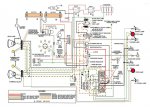OK i have a 49 Roadmaster and I need 12v for the electronic ignition, Air conditioning and the air-bags. I have no issues with the 6 volt system and it is in prime condition. Having a few mates that are electrical guys we've sat down and nutted out a wiring diagram that gives me 12v and 6v.
This involves a minimal amount of work and not too many parts.
Parts list
1. 12v alternator
2. second 6v battery (Optima style batteries are used as two will fit in the stock battery tray) 180CCA works fine
3. one 6v relay
4. one 12v accessories relay (whatever amperage you need for your accessories)
5. fuse block
6. oil pressure switch ( this is a second safety for the foot ignition system, if oil pressure is present the pressure switch will open circuit and the starter will not be able to crank)
Parts to throw over your shoulder are the generator, old ignition coil and the regulator.
I've marked up a wiring diagram as my car is built, i have a 6v fuel pump, HEI ignition and converted the reverse lights to indicators. Apart from that a stock 49 roadmaster.

This involves a minimal amount of work and not too many parts.
Parts list
1. 12v alternator
2. second 6v battery (Optima style batteries are used as two will fit in the stock battery tray) 180CCA works fine
3. one 6v relay
4. one 12v accessories relay (whatever amperage you need for your accessories)
5. fuse block
6. oil pressure switch ( this is a second safety for the foot ignition system, if oil pressure is present the pressure switch will open circuit and the starter will not be able to crank)
Parts to throw over your shoulder are the generator, old ignition coil and the regulator.
I've marked up a wiring diagram as my car is built, i have a 6v fuel pump, HEI ignition and converted the reverse lights to indicators. Apart from that a stock 49 roadmaster.



